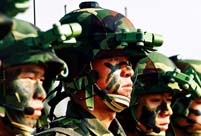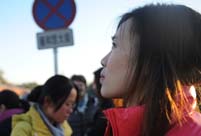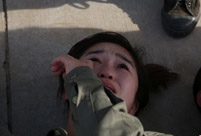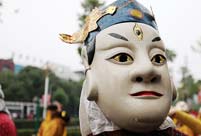KAIFENG, Henan, Dec. 6 (Xinhua) -- Kaifeng, known as the "capital of eight dynasties" for its role in China's history, is expected to regain its former glory under a national strategy that will see it turned into the center of a megalopolis.
The ancient capital will be linked with the current provincial capital of Zhengzhou in central China's Henan by a 50.5-km intercity rail line before the end of 2013. While it presently takes an hour to drive between the two cities, that transit time will be cut to 17 minutes by train.
This is the latest major step toward the status of megalopolis, which can be defined as a giant urban area consisting of several large adjoining and interconnected cities. Zhengzhou and Kaifeng have also started to use the same telecom area code, and charges on long distance and roaming calls were canceled in late October.
The Zhengzhou-Kaifeng integration is poised to be the core of the Central Plains Economic Zone, a Henan-centered cross-administrative region which covers 30 cities in Henan and the surrounding Hebei, Shandong, Shanxi and Anhui provinces.
Officials are aiming to have the zone taking shape by 2015 and built into a prosperous, environmentally friendly region by 2020.
The plans come as a shining example of China's work to tap its mass urbanization to facilitate economic upgrading and sustainable growth. As this drive was accelerated during the recently concluded key reform meeting of the Communist Party of China, new focus has been placed on Zhengzhou-Kaifeng integration.
"The formation of megalopolises during the urbanization process is a global trend," said Sun Tingxi, director of the leading group office of the zone and director of the Development and Reform Commission of Henan.
Lagging behind in China's reform and opening up in the past three decades, the central and western regions of the country are expected to generate strength from such urban structures, added Sun.
ANCIENT CAPITAL TO MEGALOPOLIS
Located in Henan's northeast, Kaifeng, the largest city in the world during the 11th century, served as capital of eight Chinese dynasties, including the prominent Han and Northern Song dynasties.
More recently, however, it has come to exist in the shadow of neighboring Zhengzhou, and is ranked as the poorest of Henan's 18 cities.
Before the implementation of the Zhengzhou-Kaifeng integration, Kaifeng's major economic indicators had not advanced in a number of years, according to Huang Daogong, the city's executive deputy mayor.
However, Huang said, the development of the megalopolis is befitting Kaifeng as it "features sharing of services and resources including telecommunications, finance, transport, industry distribution and environmental protection."
Residents and businesses in Zhengzhou and Kaifeng, which have a combined population of over 13 million, can already enjoy intra-city bank services on saving accounts, bank cards, bills and fund transfers with no cross-city charges.
A new industrial zone on the Zhengzhou-Kaifeng border has cultivated an auto parts cluster with an investment of over 12 billion yuan (about 1.97 billion U.S. dollars) from 60 enterprises including auto giants of Chery and Sumitomo.
Zhengzhou's car-manufacturing industry now sources about 90 percent of its parts from the zone, to which staff commute from both cities.
Kaifeng benefits most during the megalopolis process. According to Huang, what he calls the "dislocation development" helps magnify its strengths in historical culture, human resources and location.
Trips to Kaifeng to enjoy the local dishes and nightlife are popular with Zhengzhou residents.
In 2012, Kaifeng received 44.1 million tourists and realized tourism revenue of 18 billion yuan, year-on-year increases of 13 percent and 16 percent respectively.
BARRIERS TO BREAK
Aside from the Henan-centered Central Plains Economic Zone, China's vast inland region is witnessing five similar urban developments including the Changsha-Zhuzhou-Xiangtan City Group in Hunan, city circles around Wuhan of Hubei and Hefei of Anhui, as well as Guanzhong and Chengdu-Chongqing urban agglomerations.
It is hoped that the formation of these megalopolises will enhance their advantages of location, market potential, dense population, convenient transportation and high urban density.
Meanwhile, experts have noted, they suffer from the same dilemmas as the rest of China, such as imbalances between urban and rural sectors, and economic structural contradictions.
The integrated development of megalopolises will embolden central and local governments to be more courageous in breaking administrative and institutional barriers, said Geng Mingzhai, vice chairman with the Economic Association of Henan.
He suggested replacing the current designation "administrative city" with "economic cities," which would feature integrative planning on traffic and industry distribution, public services as well as environmental protection.
More importantly, the central government must shape megalopolis development with top-level design by deepening the household registration and social security system reforms, he also urged.
 Heavy cargo flights taking off
Heavy cargo flights taking off In pictures: PLA's digital equipment
In pictures: PLA's digital equipment  Americans mark Thanksgiving Day with parades
Americans mark Thanksgiving Day with parades Love searching stories in cities
Love searching stories in cities  Shanghai shrouded in heavy fog
Shanghai shrouded in heavy fog Office ladies receive ‘devil’ training in mud
Office ladies receive ‘devil’ training in mud China's first nude photographer
China's first nude photographer Selected sports photos of the week
Selected sports photos of the week Treasure of Chinese culture- Nuo Dance
Treasure of Chinese culture- Nuo Dance  Youths in Night club: photo story
Youths in Night club: photo story Models dazzle at Int'l Yacht Model Pageant
Models dazzle at Int'l Yacht Model Pageant  Crystal scenery in China: Jilin fog glaze
Crystal scenery in China: Jilin fog glaze  Tianjin holds first pole dance championship
Tianjin holds first pole dance championship  Annual Santa Claus parade held in Canada's Montreal
Annual Santa Claus parade held in Canada's Montreal China's aircraft carrier passes through Taiwan Strait
China's aircraft carrier passes through Taiwan StraitDay|Week|Month